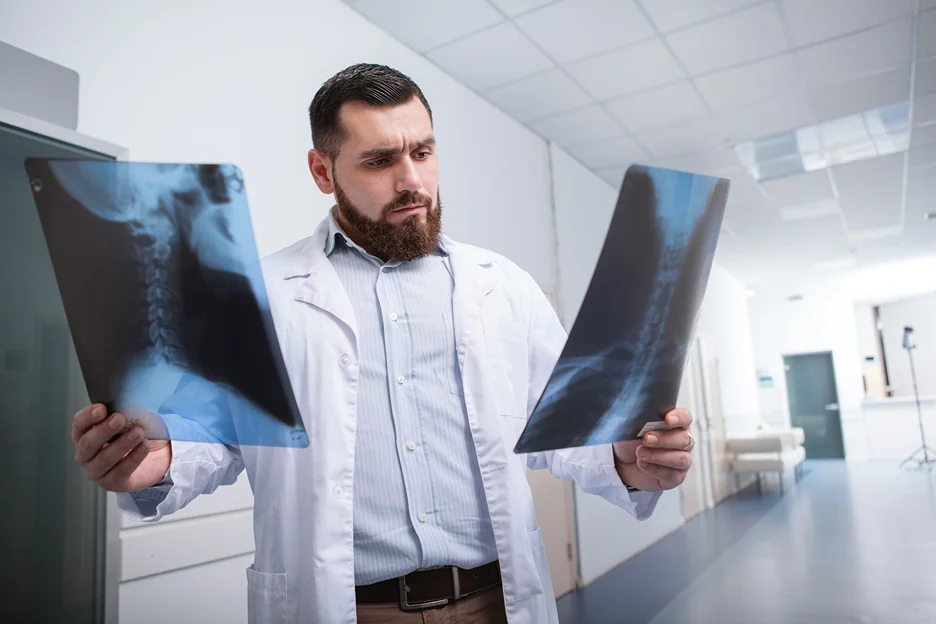Sharp neck pain, often experienced as a sudden and intense discomfort in the neck area, is distinct from the lingering, dull ache characteristic of chronic neck pain.
While both forms of pain are concerning, sharp neck pain usually demands immediate attention due to its abrupt onset.
Understanding the nuances between these two types of pain is crucial. It aids in seeking timely treatment and ensuring that the underlying issues are correctly identified and managed.
Differentiating Sharp Neck Pain from Chronic Neck Pain
While sharp neck pain is sudden and mostly short-term, chronic neck pain usually develops slowly and lingers. Regardless of the type, professional medical advice ensures the right treatment pathway.
| Characteristic | Sharp Neck Pain | Chronic Neck Pain |
| Onset | Sudden, often due to an identifiable injury or strain. | Gradual, may or may not have an identifiable cause. |
| Duration | Typically lasts less than 4 weeks. Resolves with time and treatment of underlying soft tissue injury. | Lasts 3 months or longer. May be a sign of ongoing underlying condition(s). |
| Intensity | Usually severe, sharp, excruciating pain. May improve or worsen with movement. | Dull, constant ache or throbbing. Intensity does not correlate with severity. |
| Symptoms | Neck stiffness limiting rotation. Pain made worse with head movements. | Persistent neck pain. May have referred pain in shoulders/arms. Pain level does not vary much. |
| Causes | Muscle strain, ligament sprain from poor posture, sudden injury. | Degeneration, arthritis, myofascial pain, heart/lung issues, fibromyalgia, slipped disc. |
| Treatment | RICE therapy, heat/ice, over-the-counter pain relievers, muscle relaxants. Physical therapy if prolonged. | Treatment targets underlying cause. May include medications, injections, physical therapy, lifestyle changes. |
| Prognosis | Good, usually resolves within 4 weeks with treatment/rest. | Varies depending on cause. May require long-term management options. |
| Risk Factors | Poor posture, looking down at devices, sudden injury. | Genetics, age, occupation/strenuous activities, trauma history, chronic conditions. |
| Red Flags | Numbness, weakness, bone tenderness, uncontrolled pain. | Unexplained weight loss, fever, morning stiffness lasting >30 min. |
What’s Behind That Sharp Neck Pain?
Muscular Causes
The muscles in our neck are highly active and integral to daily movement. However, they are susceptible to strains and sprains, often resulting from poor posture, overexertion, or sudden movements.
Skeletal Causes
The structural components of our neck, including the bones and discs, are not immune to conditions causing sharp pain.
Instances of cervical disc herniation, where a neck disc gets damaged, or cervical stenosis, the narrowing of the spinal canal in the neck, are significant contributors.
Also, bone spurs, or bony growths developing due to inflammation or injury, can be culprits for this type of pain.
Nervous System Causes
The nervous system, the communication network of our body, can also be a source of sharp neck pain. Cervical radiculopathy, commonly referred to as a pinched nerve, is a classic example.
Other Causes
A myriad of other causes can manifest as sharp neck pain. Infections and tumors in the neck region are two such causes. Notably, referred pain from other organs, especially the heart, can also be perceived in the neck.
For instance, a heart attack might present not just with chest pain but also accompanying neck pain, emphasizing the importance of recognizing diverse symptoms.
Diagnostic Approaches for Sharp Neck Pain

Diagnosing the root cause of sharp neck pain is a systematic process. Healthcare professionals utilize various tools and techniques to get a clear picture of what’s going on beneath the surface. By understanding the specific cause, treatments can be more targeted and effective.
Physical Examination
During a physical assessment, physicians usually check for tenderness, swelling, and palpable abnormalities in the neck. They may also evaluate the range of motion, strength, and reflexes to discern any neurological issues.
Imaging Studies
MRI (Magnetic Resonance Imaging), CT (Computed Tomography) scans, and X-rays are invaluable tools. They provide a detailed visual insight into the neck’s anatomy, highlighting potential issues like disc herniations, bone spurs, or other structural abnormalities.
Other Diagnostic Tools
Nerve conduction studies can be utilized to determine nerve function, especially if there’s suspicion of a pinched nerve. Blood tests can help identify infections or inflammatory markers indicative of certain conditions causing neck pain.
Treatment Options
Once the root cause of sharp neck pain has been identified, the next step is formulating a treatment plan. The goal is to alleviate discomfort, promote healing, and, where possible, prevent future occurrences.
Immediate Care
Physical Therapy
A physical therapist can guide patients through specific exercises and stretches. These not only alleviate pain but also fortify the neck muscles, promoting long-term health and reducing recurrence risk.
Medication
For more severe pain, physicians might prescribe powerful pain relievers, muscle relaxants, or even corticosteroid injections to reduce inflammation.
Surgical Interventions
Surgery is typically a last resort, reserved for cases where conservative treatments don’t provide relief. Common procedures include cervical disc replacement or cervical spinal fusion.
Prevention and Management
While treatments can effectively address sharp neck pain, prevention is the ultimate goal. By integrating certain habits and practices into our daily lives, we can protect our necks and promote their overall well-being.
Postural Corrections
Maintaining a neutral spine, especially when sitting for extended periods, is crucial. Correct posture can prevent undue strain and reduce the risk of injuries.
Ergonomics
Ergonomically designed workspaces—adjustable chairs, monitor risers, and keyboard trays—can significantly minimize neck strain.
Routine Exercises
Regular strengthening and stretching exercises, especially for the neck and upper back, can fortify muscles and enhance flexibility.
Lifestyle Factors
Managing stress through relaxation techniques, maintaining a healthy weight to reduce neck strain, and avoiding smoking (which can impede spinal health) are pivotal for neck well-being.
Wrapping Up: Sharp Neck Pain
Sharp neck pain, though common, shouldn’t be brushed aside or taken lightly.
As we’ve explored, its causes can range from simple muscular strains to more complex issues involving the nervous system. Each cause requires a tailored approach in terms of diagnosis, treatment, and prevention.
Whether it’s an occasional twinge from a poor night’s sleep or a more persistent ache hinting at an underlying condition, awareness is the first step towards resolution.
Should you or anyone you know experience persistent or severe neck pain, it’s vital to seek medical advice. Early intervention can not only provide relief but can also prevent potential complications down the road.
Consult Kaly for Your Neck Pain Needs

Whether you’re experiencing new sharp neck pain or long-term chronic neck pain, Kaly can help. Our specialized health professionals are experts in assessing neck issues and creating individualized treatment plans.
From gentle manual therapies and customized exercises to corticosteroid injections, we have a variety of options to help relieve both acute and persistent neck pain.
Contact us today to schedule an evaluation. Our friendly staff can answer any questions you have about your neck symptoms and insurance coverage. Don’t continue suffering in pain – contact Kaly and start feeling better.
